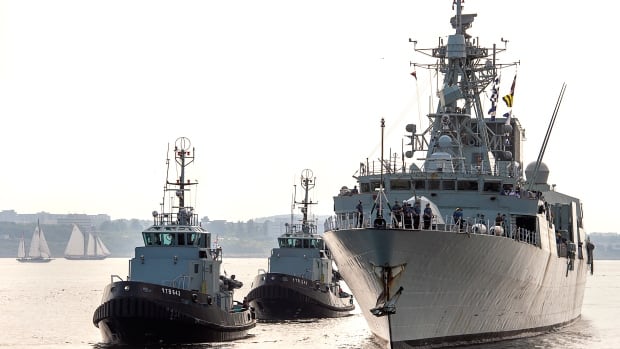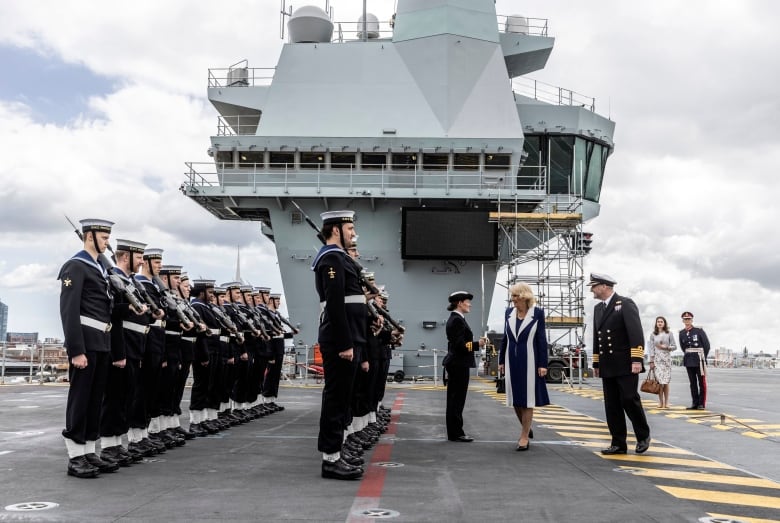
Canada’s budget watchdog estimates it will cost taxpayers over $306 billion to buy, own, operate and eventually dispose of the navy’s new frigates.
That eye-popping price tag for the 15 surface combatants, contained in a new report released Thursday, is spread out over 65 years — the anticipated lifespan of the warships.
Parliamentary Budget Officer Yves Giroux now forecasts that construction costs could hit $84.5 billion — a nine per cent increase over the watchdog’s last estimate in 2021.
If that estimate is correct, each of those frigates could cost Canada more than what Britain paid recently for each of its two new aircraft carriers.
“This new evaluation takes into account revised production schedules and amended inflation projections,” said Giroux.

The Department of National Defence said Thursday it’s standing by its existing projection of design and construction costs in the range of $56 billion to $60 billion.
“However, as we progress through this phase, the cost estimate will be updated,” said department spokesperson Jessica Lamirande in a media statement.
Construction of the first of the new frigates is not expected to begin until 2024. The warships are expected to be in service until late the 2070s, when the final vessel reaches the end of its service.
Speaking to reporters following the release of the report, Giroux said the design and acquisition phase is the part of the program where the federal government — at the moment — has the most fiscal control. The PBO report estimates it will cost around $219.8 billion to operate the fleet of new warships over nearly six decades.
Lamirande said DND’s operating estimate runs between $183 billion and $208 billion but noted that it also is subject to revision.
It’s the rising cost of buying each ship that concerns members of the House of Commons standing committee on government operations and estimates (OGGO), which requested the PBO review.
The PBO started tracking the price tag in earnest in 2017 after the Liberal government chose the British Type 26 frigate design as the basis for the new Canadian surface fleet. Back then, the budget watchdog ballparked the acquisition price tag at $62 billion.
Postponing construction will cost us: PBO
That price tag, Giroux said Thursday, steadily increased as the design was refined and adapted to Canada’s needs — and as the federal government pushed back the launch of construction.
While there has been a lot of speculation about the damage rising inflation will do to the frigate program budget, Giroux said the recent decision to postpone construction of the first warship to 2024-25 had the largest impact on the latest estimate.
“It’s difficult to disentangle which one is the biggest impact,” Giroux said. “Delay is more expensive, one year for the first ship, up to four years for the subsequent ships. It’s a significant cost driver.”
When the PBO’s estimate of $84.5 billion to design and build the frigates is averaged out over the size of the fleet — 15 in total — each warship would have an average estimated cost of approximately $5.6 billion.
That, Giroux said, is a “significant” sum.

Although his report doesn’t go into international comparisons, the average Canadian estimate of the cost per ship is now more than what the United Kingdom says it paid to build its latest 65,000 tonne aircraft carrier, HMS Prince of Wales. The price tag for that complex warship is reportedly just over £3 billion — or $4.7 billion Cdn.
In Washington late last year, the U.S. Navy pegged the cost of its new aircraft carrier, the USS Gerald Ford, at $13 billion US.
The U.K., which is also building frigates based on the Type 26 design, is reportedly paying £1.23 billion — or $1.93 billion Cdn — for each of the warships.
Dave Perry, one of the country’s leading experts on defence procurement, said the comparison to what other nations are paying is “somewhat unfair” because we have no sense of what the British are counting as part of their estimate.
“So without knowing what went into the other figures, it’s tough to get a good sense of how to meaningfully compare them. But at the same time, you know, I do think there’s no question that we are building expensive ships,” said Perry, vice president of the Canadian Global Affairs Institute, an Ottawa-based think-tank that occasionally has hosted events sponsored by major defence contractors.
And with the kind of weapons and surveillance systems the Canadians are packing into the warships, he said, it’s not accurate to think of them as frigates anymore. They will be more like high-end destroyers, Perry said.
Giroux said Canada could save money with an entirely different approach.
“Well, it’s clear that Canada is paying significantly for each of these ships, and there would be alternatives where the costs would be lowered,” he said. “For example, if we were to buy foreign ships that were to be built abroad.
“But that’s a decision that the government has to make and parliamentarians have to debate as to whether this is the best value for money, taking into consideration the benefit of having a domestic building capacity or domestic shipyard capacity to build warships, as well as the benefits of of having the expertise domestically, as opposed to purchasing the ships from abroad, based on foreign designs.”
‘Every time we look at this, the costs go up’
When it launched the National Shipbuilding Program more than a decade ago, the Conservative government of former prime minister Stephen Harper said taxpayers would be protected from runaway costs by “rigorous oversight” and shipyard audits.
Giroux wouldn’t offer a definitive take of whether the federal government has a handle on the frigate program’s budget.
“I can’t comment specifically on whether they have control or not,” he had. “Our mandate is to provide a cost estimate, and every time we look at this, the costs go up.”
Perry said that since the warships are still in the design phase, the heavy lifting when it comes to budget oversight will happen once a formal contract is signed with a shipyard and construction begins.
The biggest concern, he said, involves the delay in starting construction of the first ship because that pushes up the overall cost.
“Any amount of scheduled delay has a really consequential impact,” said Perry. “I hope this is the last time that PBO needs to tack on another several billion dollars because of scheduled delays.”
Giroux said the rising naval production cost will strain the Department of National Defence’s budget in the coming years and suggested it could affect other capital purchases, such as the air force’s plan to replace its aging CF-18 jet fighters with new F-35 stealth fighters.